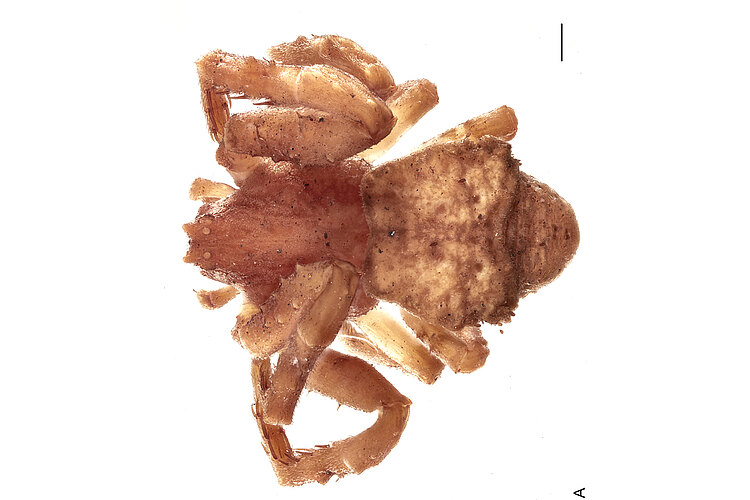Two-horned Crab Spider Stephanopis bicornis L. Koch, 1874
Fauna Portal species: 9405Diagnosis
(after Machado et al. 2019): Both males and females of S. bicornis are similar to those of S. angulata, S. lata and S. monulfi in possessing a trapezoidal opisthosoma and having the triad of projections arranged in a dorsal row along the anterior patellae and tibiae (I and II). However, S. bicornis can be easily distinguished by the high and acute projections above the anterior lateral eyes. Females are also diagnosed by their slit-shaped copulatory openings located laterally at the edges of the epigynal plate, with its folds forming round entrances; males have a characteristic pedipalp with a prolateral tuft of short serrated setae on the dorsal surface of the cymbium and a hook-shaped retrolateral tibial apophysis (RTA) with squared and discrete RTAvbr.
Status
- native
Australia
- New South Wales
- Queensland
- South Australia
- Tasmania
Neighbouring Countries
- Indonesia
- Papua New Guinea
Fauna Portal Records
The map shows all records that have been verified as part of the Fauna Portal project and may not represent the true distribution of a species. Specifically, for described species, check the link to the Atlas of Living Australia on this page for potential wider distributions. Fauna Portal Reference specimens and Linnean types are shown in red. If you identified a specimen that exceeds the distribution of an undescribed species as illustrated here, please contact the Fauna Portal team who can assist with the lodgement of the specimen in a public institution and display on the map.
Publications
Dupérré N (2023): New light on some historical type specimens - in relation to the South American spider (Araneae) fauna. New Zealand Journal of Zoology. 50: 118 - 277DOI
Machado M, Teixeira RA, Milledge GA (2019): On the Australian bark crab spider genus Stephanopis: taxonomic review and description of seven new species (Araneae: Thomisidae: Stephanopinae). Records of the Australian Museum. 71: 217 - 276
Araneae (Spiders)
- Actinopodidae
- Anamidae
- Araneae fam. indet.
- Araneidae
- Archaeidae
- Argyronetidae
- Arkyidae
- Barychelidae
- Cheiracanthiidae
- Clubionidae
- Corinnidae
- Cycloctenidae
- Deinopidae
- Desidae
- Dictynidae
- Filistatidae
- Gnaphosidae
- Halonoproctidae
- Hersiliidae
- Idiopidae
- Lamponidae
- Linyphiidae
- Lycosidae
- Mimetidae
- Miturgidae
- Mysmenidae
- Nicodamidae
- Oecobiidae
- Oonopidae
- Oxyopidae
- Philodromidae
- Pholcidae
- Pisauridae
- Prodidomidae
- Salticidae
- Scytodidae
- Segestriidae
- Selenopidae
- Sparassidae
- Symphytognathidae
- Tetrablemmidae
- Tetragnathidae
- Theridiidae
- Thomisidae
- Trachelidae
- Trachycosmidae
- Trochanteriidae
- Uloboridae
- Zodariidae
- Zoropsidae
All classes
- Arachnida
- Crustacea
- Entognatha
- Gastropoda
- Insecta
- Orthoptera - Caelifera (Grasshoppers)
- Hymenoptera excl. Formicidae (bees and wasps)
- Blattodea s. str. (Cockroaches)
- Coleoptera (Beetles)
- Dermaptera (earwigs)
- Diptera (flies, mosquitos)
- Entomobryomorpha (slender springtails)
- Hemiptera - Heteroptera (True Bugs)
- Hemiptera - Sternorrhyncha (aphids, scales etc.)
- Hemiptera - Auchenorrhyncha (cicadas, planthoppers)
- Hymenoptera - Formicidae (Ants)
- Trichoptera (Caddisflies)
- Zygentoma (silverfish)
- Myriapoda

